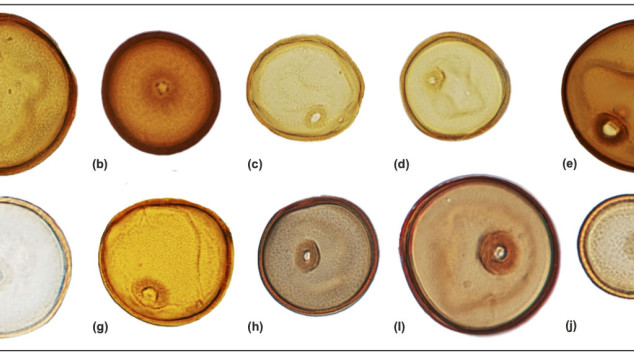Palaeoecology Reference Collection

Details
- Infrastructure type
- Collections - cultures / museum
- Institute
The facility
Reference material is available for the identification of micro-fossils (including pollen, spores, phytoliths, and non-pollen palynomorphs), and macro-fossils (including seeds, and sediments).
Material focuses on temperate (north-west European) and tropical (South America, Africa and Asia) regions. Reference material is used of research and teaching within the University of Amsterdam, and is available to be consulted by researchers at other institutions.
Some elements of the collection have been digitised and can be accessed online in databases (Cleef & Reyes, 2022a; Cleef & Reyes, 2022b; Hooghiemstra et al., 2017; Teunissen van Manen, 2015), and in publications (Huang et al., 2021; McMichael et al., 2019; van Geel, 2001; van Geel & Aproot, 2006; Wei, 2023; Woutersen et al., 2023).
Archived palaeoeoclogical material is avaliable from study sites around the globe and relates to publications since the 1960s (Hooghiemstra, 2015).
Research topics
Non-pollen palynomorphs, Palynology, Phytoliths, Pollen, Seeds, Sediments, Spores
References
- Cleef, A.M. & Reyes, P. (2022) Páramo vegetation research, Venezuela: Occurrence data (version 8.6). University of Amsterdam, GBIF: https://doi.org/10.15468/fx2vum
- Cleef, A.M. & Reyes, P. (2022b) Páramo Vegetation Research, Paramo "El Almorzadero", Colombia: Occurrence data (version 10.5). University of Amsterdam, GBIF: https://doi.org/10.15468/0uv5bv
- Hooghiemstra, H., Lyaruu, A. & Cleef, A. (2017) Páramo pollen reference collection: Occurrence data (version 10.3). University of Amsterdam, GBIF: https://doi.org/10.15468/aa9jxr
- Hooghiemstra, H. (2015) 50 years of teaching and research in palynology at the University of Amsterdam, the Netherlands. Palynos 37(2)/38, 16-19. https://www.palynology.info/palynos/
- Huang, H., Pérez-Pinedo, D., Morley, R.J., Dupont-Nivet, G., Philip, A., Win, Z., Aung, D.W., Licht, A., Jardine, P.E. & Hoorn, C. (2021) At a crossroads: The late Eocene flora of central Myanmar owes its composition to plate collision and tropical climate. Review of Palaeobotany and Palynology 291, 104441. https://doi.org/10.1016/j.revpalbo.2021.104441
- McMichael, C.N.H., de Wolf, I.K. & Land, K. (2019) Chapter 7 - Phytolith analysis of soil archives: phytoliths in soils of the Netherlands. Developments in Quaternary Sciences 18, 251-27. https://doi.org/10.1016/B978-0-444-64108-3.00007-0
- Teunissen van Manen, M. (2015) Miocene Amazonian Palynological Diversity: Image files. University of Amsterdam, FigShare: https://doi.org/10.6084/m9.figshare.1396453.v6
- van Geel, B. (2001) Non-pollen palynomorphs. Tracking environmental change using lake sediments. Vol. 3 (ed. by J.P. Smol, H.J.B. Birks & W.M. Last), pp. 99-119. Kluwer, Dordrecht. https://doi.org/10.1007/0-306-47668-1_6
- van Geel, B. & Aptroot, A. (2006) Fossil ascomycetes in Quaternary deposits. Nova Hedwigia 82, 313-329. http://dx.doi.org/10.1127/0029-5035/2006/0082-0313
- Wei, C. (2023) Morphometrics of modern and fossil Poaceae pollen from South America. PhD Thesis, University of Amsetrdam. https://hdl.handle.net/11245.1/1f4f5550-1069-423a-ace3-2192ac4160c6
- Woutersen, A., Jardine, P.E., Silvestro, D., Bogotá-Angel, R.G., Zhang, H., Meijer, N., Bouchal, J., Barbolini, N., Dupont-Nivet, G., Koutsodendris, A., Antonelli, A. & Hoorn, C. (2023) The evolutionary history of the Central Asian steppe-desert taxon Nitraria (Nitrariaceae) as revealed by integration of fossil pollen morphology and molecular data. Botanical Journal of the Linnean Society 202, 195-214. https://doi.org/10.1016/j.revpalbo.2023.104914
Running period
The Palaeoecological Reference Collection has its origins in the 1960s when Thomas van der Hammen commenced palynological research at the University of Amsterdam. It has been subsequently developed over the following decades by many researchers based at the University of Amsterdam, notably Henry Hooghiemstra and Bas van Geel (Hooghiemstra, 2015). There is no specific funding dedicated to the maintenance of the collection, with particular aspects being developed in relation to specific projects, funding streams, or educational needs.
Equipment
The microfossil component of the Palaeoeology Reference Collection is based upon approximately 10,000 residues of different taxa. Microscope slides of these residues are available for examination. The macrofossil component comprises boxes containing approximately 5000 specimens. The Pollen Laboratory contains microscope facilities for the examination of specimens at both high and low power magnification.
Data management
The Palaeoecology Reference Collection is available for consultation within the Pollen Laboratory, but material cannot be removed. A portion of the collection is available online through databases and published scientific articles (see references above). The material is used to provide a reference point for morphological identification, and for specific research projects, e.g. examination of morphological variation between, and within, taxonomic groups (Wei, 2023). Microscope analysis is non-destructive so material is available for re-use, however, slides can degrade through time. Therefore, reference residues for all microfossil reference material are held in addition to the reference slides so that new slides can be made in the event of slide degradation.
Available datasets
All material housed within the collection is available for consultation on site. A portion of the information related to the collections is available online through databases and in the scientific literature (see references above).
Conditions for access
Access to the Palaeoecology Reference Collection can be gained through contacting the researcher involved and/or the laboratory managers. People interested to access the facilities should provide an overview of their research plans involving the collection and information on their specific interests: (i) the type of collection (e.g. pollen or phytoliths), (ii) geographic region, (iii) potential collaborations with personnel at IBED, and (iv) preferred time and duration of visit.
The use of the Palaeoecology Reference Collection by external researchers should be acknowledged in any resultant publications. The development of collaborations with researchers at the University of Amsterdam is strongly encouraged.
Short-term (days to weeks) consultation of the material can be arranged on an ad hoc basis and does not include a charge. Long-term (weeks to months) projects focused on the collections may incur bench fee costs related to the use of the laboratory space.
Details
- Infrastructure type
- Collections - cultures / museum
- Institute
Experts
Scientific enquiries:
- Prof. William Gosling | University of Amsterdam
- Dr Crystal McMichael | University of Amsterdam
- Dr Carina Hoorn | University of Amsterdam
Laboratory enquiries:
Location
Science Park 904
1098 XH Amsterdam
Netherlands



